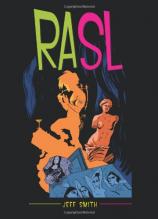RASL
Review
RASL
Jeff Smith is something of a comics anomaly. After a short career in animation, Smith launched his own publishing company, Cartoon Books, in 1991, spurred on by the recent successes of “serious” comics by the likes of Frank Miller, Alan Moore and Art Spiegelman. Over the next 13 years, he would produce --- and, originally, self-publish --- 55 issues of the sprawling all-ages fantasy masterpiece BONE. His work on the series won him ten Eisner and 11 Harvey Awards.
After a few BONE spinoffs and some work for DC Comics, Fantagraphics and the post-hardcore band Say Anything, Smith returned to self-publishing in 2008 with RASL, a hardboiled sci-fi odyssey following an interdimensional art thief with a past that’s rapidly catching up to him. Like BONE, which ran as a black-and-white serial, RASL was released sequentially and compiled into a full-color collection, albeit in a much shorter four-year run.
Yet unlike his earlier all-ages epic fantasy, RASL is very much for adults only. For one, Smith’s art is decidedly more jagged and realistic here than it was in the lovely but cartoony, caricature-heavy BONE. Then there’s the story itself. A gritty science fiction noir taking place in a multidimensional series of American Southwests, RASL is filled enough gunfights, car chases, sexual encounters, lizard-faced hit men and secretive governmental organizations to leave fans of early Bruce Willis movies more than satisfied.
The thing is, RASL is complicated. The backstory is heady, involving quantum physics, Maxwell’s equations and electromagnetism, spectral apparitions, the lost journals of Nikola Tesla, military conspiracy theories regarding the disappearance of said journals, and mythologies of Southwestern Native American tribes. This is not a tale to be read lightly.
In a former life, the art thief Rasl was an esteemed physicist named Robert, who was working on a project for the American government involving some of Tesla’s strangest theories. The idea, of course, was to create a machine to end all wars. But something about the project disturbed Robert deeply enough to cause him to destroy the secret facility at which he worked and run off with one of his inventions --- a device called a “T-Suit,” which allowed Rasl to project himself between alternate dimensions using electromagnetic currents. Needless to say, those privy to the project weren’t thrilled to see this equipment go missing… and had no desire to let it remain in Rasl’s hands.
In RASL, Smith juggles a whole dimension’s load of concepts, yet does so seemingly effortlessly. Even the ends that remain loose seem to have been left so deliberately, to add to the eeriness of the tale and to remind the reader that even in science, some happenings are simply beyond our fathoming. As in BONE, Smith shows how masterful he is at crafting a story that can work fully within a genre yet remain unconfined by its limits. (There is one unfortunate exception to this rule, and ---unsurprisingly, for a pseudoscience-heavy noir --- it’s the story’s bevy of one-note women, that apparently endless slew of distressed damsels and fatal femmes entangled in fateful romances with our hero.)
To top it all, the hard-boiled plot is perfectly served by its setting: the achingly empty Southwest, baked as it is in brick red and warm oranges and countered by that gigantic sky. The sheer space of the location allows Smith to effectively juxtapose the story’s moments of dense action with something huge, alien and messily stunning --- just like RASL itself.
Reviewed by John Maher on August 15, 2014
RASL
- Publication Date: September 17, 2013
- Genres: Comic Books, Graphic Novel, Science Fiction
- Hardcover: 472 pages
- Publisher: Cartoon Books
- ISBN-10: 1888963379
- ISBN-13: 9781888963373




